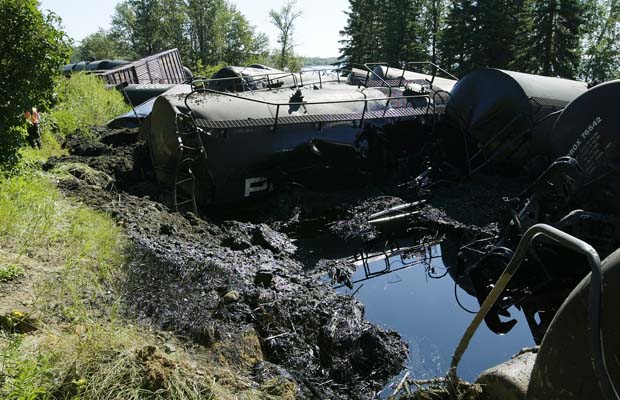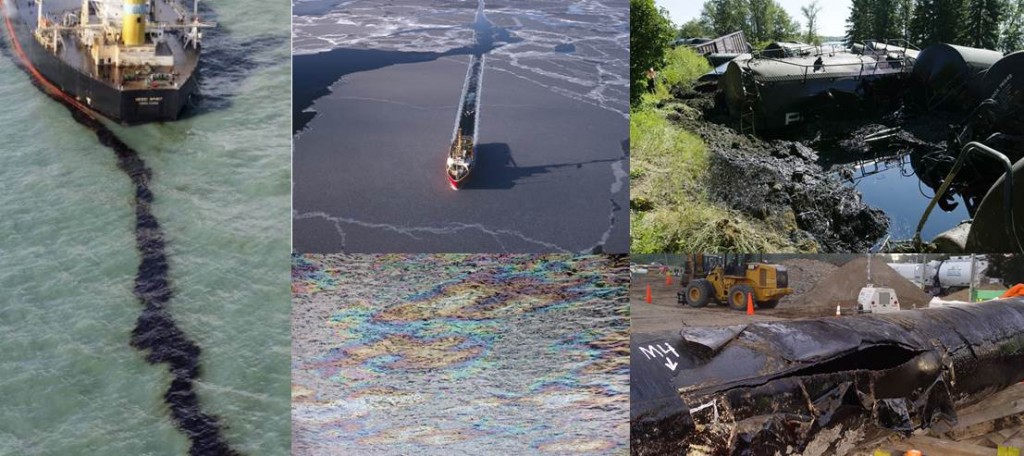July 11, 2014 – This morning as I perused my many alerts and feeds I came across a headline from The National, a paper published out of the United Arab Emirates. Its title, How Satellites could help to contain oil spills in the Arabian Gulf. The author points out the Arabian or Persian Gulf as we here in the West call it, contains 800 offshore platforms for oil and gas and 25 major drill and terminal sites. These produce eight major spills annually. Because of the damage these spills do to the environment the oil producers are using real-time satellite surveillance communicated to the Masdar Institute’s Coastal and Environmental Remote Sensing facility. The data collected predicts the size and trajectory of each spill so that the UAE can deal with the cleanup and recovery.
That wasn’t the only headline. From the Albuquerque Journal I read about a crude oil producer using a rail spur line near the town of Bernalillo, New Mexico, and not notifying any local officials about their trucking and oil transhipment operation. This immediately brought to mind the Lac Megantic rail disaster that killed almost 50 and engulfed in flame a small Quebec town. When discovered the company, NuDeveCo, began the application process to get permission to transship up to 1,200 barrels of oil from a field in northwestern New Mexico. But when the town raised concerns the application process stopped. It turns out similar transshipping operations are popping up all over the U.S. Mid and Far West and raising the same fears raised by Bernalillo. What would happen if their town experience a nearby spill? Could there be a fire? Could groundwater become contaminated? Could farm and wildlife let alone humans be victims of the environmental impact?
In Nunavut in the Canadian Arctic, another published study, entitled Oil Spill Detection and Modeling Report in the Hudson and Davis Straits, commissioned by the Nunavut Planning Commission, in anticipation of Arctic oil exploration in its waters, reported in the last few weeks that “there is very limited knowledge of how to respond to an oil spill in waters off Nunavut or how to predict how far spilled oil could travel under sea ice.” The concern is about the impact on the livelihood of Nunavut’s population which relies on hunting and fishing for a high percentage of the local diet. Alarmingly the research on oil spillls that this study compiled “found that sea ice is not considered in most oil spill models.” Complications to any oil spill would be determined by the timing of the spill. If it occurred during the period of winter freeze then the oil would be trapped under ice until the spring thaw and would travel with ice floes in the break up. How do you contain and clean up a spill then?
My further reading found a list of most recent oil spills including a break in a pipeline in Los Angeles last May, and in March spills from a refinery on the shore of Lake Michigan, a spill in the Houston Ship Channel, and a North Dakota pipeline spill. That led me to look at North Dakota alone, the site of the Bakken oil shales. Since 2012 in that state there have been 300 spills from 28,160 kilometers (17,500 miles) of pipeline. The regulators, however, under North Dakota law, are not obliged to inform the public.
We know it isn’t getting easier to find oil these days. And where and when we do it appears we are not sufficiently prepared to handle it with any assurance that we will not cause environmental catastrophes from small to large. One accident at a drilling platform in the Arctic could create a nightmare legacy of destruction lasting a century or more because we have insufficient technology to contain and clean up after such an event. And where we do find oil in places like the Bakken developers and shippers continue to repeat mistakes that could conceivably lead to another tragedy like Lac Megantic, let alone to spills unreported to the public that have long-term environmental consequences for wildlife, agriculture and groundwater.
So what to do? We remain addicted to fossil fuels but there should be going forward much tighter regulation on where we go and find the stuff. The days of “drill baby drill” have to come to an end. And obviously the less we need oil the better off the planet will be. So we should be hell bent on developing alternative energy technologies while implementing conservation practices for oil we do use.
In the case of the latter, we have a smattering of regulation from local state and provincial governments in North America, and in other jurisdictions around the world. But no global agreement on oil conservation which should be included in any environmental agreement such as the one coming out of the next climate change summit taking place in Paris in 2015. Why should oil conservation be a part of that conversation? Because conservation will reduce oil’s contribution to greenhouse gas emissions. And the less oil we use the better off our planet will be.






















